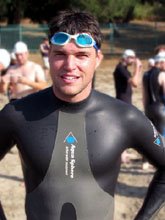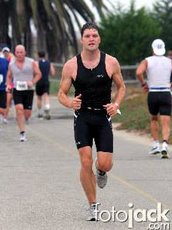The last four weeks or so I've put myself on a variation of a program called the "Strength-Focused Mesocycle" from Chad Waterbury's book MUSCLE REVOLUTION, which I've just about worn myself out recommending to anyone interested in strength training.
The SFM, as Waterbury affectionately calls his program, is pretty simple in design (that's one thing I love about Waterbury): three workouts a week, FOUR exercises per workout, THREE sets per exercise, and THREE to EIGHT reps per set. For you 'math people,' that's a whopping 36-96 reps per WORKOUT.
Most gym rats will crank out that many reps for a teensy little muscle group like the forearm flexors. How could anyone progress with so little stimulation, much less a chalky, seasoned gym denizen like myself?
The VERY FIRST weight training program I ever did regularly was the Soloflex workout. Soloflex, for you spring chickens out there, was a sort of precursor to the Bowflex: a compact, high-end home workout machine. Long before I was able to save up enough wadded-up-dollar-and-a-quarters from my after-school job delivering the Valley News to afford the actual machine, I managed to figure out the Soloflex exercise program by watching their promo video. With my DP weight set and a chin-up bar, I simply did the free-weight versions of the exercises they recommended. When my Soloflex finally arrived, I switched over to the machine versions of the free-weight moves I was doing (and, irony of ironies, promptly stopped making progress--but that's the subject for another post).
Anyway, their program, which I started doing at age 16, was a three-day-a-week program consisting of six exercises, done for three sets of twelve reps each. I could almost recite for you the exercise order and rest between sets. As such, it had about 33% more volume than the program I'm now on.
And yet I've managed to build a pretty significant amount of strength on the program, while at the same time experiencing less pain in my joints and back than I had on higher-volume programs. Moreover, I'm now able to spend more time doing warm-up and cool-down moves and high-intensity cardio sessions without neglecting the rest of my life too much.
The key, it seems, is intensity. I was perusing Alwyn Cosgrove's blog this morning, and darned if that little Scotsman didn't drop this brilliant little pearl of wisdom without even thinking about it:
" I think volume is the least important exercise variable. Intensity is number one and frequency is probably number two."
I'm going write that again: INTENSITY IS THE NUMBER ONE MOST IMPORTANT EXERCISE VARIABLE.
In the world of exercise science, you can find about a half-dozen definitions of 'intensity,' but I think that Cosgrove means the word not as "percentage of one-rep maximum," which is how you'll see it defined by exercise-physio-geeks, but in the layman's sense of the 'focus and intention' behind one's efforts. It's ultimately a highly subjective criterion: only you can say if you really worked at your edge.
Now: most fitness bigwigs out there would agree that there is a point of diminishing returns to the pursuit of intensity at all costs (I definitely stop short of recommending extensive use of forced reps and negative repetitions, for example). A quick look around the average gym makes it clear that too much intensity is decidedly NOT the problem with most peoples' workouts, however. The problem is too much emphasis on volume and not enough on intensity.
My progress on the low-volume, high-intensity SFM has brought this point home to me yet again. Bring your volume down, and your intensity will go up. Quality, not quantity.
I read not too long ago that truly elite skaters spend almost 70% of their practice time on unfamiliar activities, whereas lesser athletes spent about half their time on them. Most of the elites' practice time is spend struggling to master new skills rather than belaboring old ones.
Put another way, the really great ones' practice time is spent FAILING and the mortals' practice time is spent SHOWING OFF. Lesser skaters spend more time in the comfort of the known, while the greats do battle with the darkness and frustration of the unfamiliar.
Ironically, the mortals probably look better, more graceful and competent in practice, whereas the greats look awkward and tentative as they test their legs on new moves they haven't quite gotten the hang of yet. Watching them, you might even mistake one group for the other. In competition, however, the bling around the necks of the fearless ones tells the true story.
In the gym the other day, I tried to figure out what percentage of my workout was spent doing things I'd done before, where success was pretty much guaranteed, as opposed to things that made me nervously look around for a spotter if I got myself into trouble. Suffice it to say that, by the standards of the skaters in the study, I'm the mortalest of mortals.
But it's something to shoot for.
Tuesday, March 11, 2008
Subscribe to:
Comments (Atom)



